Header logo
header top contact widget
Gingivectomy
Six Reasons To Have Your Dental Implants Placed By A Periodontist
Posted on Jul 12, 2023 by William J. Claiborne, DDS MS
A periodontist is a dental specialist who is often in the background of various dental procedures. Yet, we are in the forefront when it comes to specialized skills that support specific treatment needs.
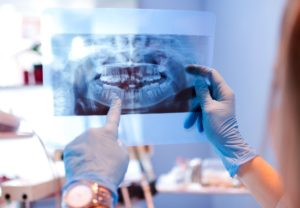 Most patients are referred to our Asheville periodontal dental office by general dentists and dental specialists to provide certain aspects of dental treatment, which may involve our skills in cosmetic dentistry, dental implants, and treating all stages of gum disease.
Most patients are referred to our Asheville periodontal dental office by general dentists and dental specialists to provide certain aspects of dental treatment, which may involve our skills in cosmetic dentistry, dental implants, and treating all stages of gum disease.
A periodontist has advanced training to properly diagnose and treat all stages of periodontal (gum) disease (including gingivitis and periodontitis) as well as placement of dental implants. In addition, periodontists are particularly skilled in performing cosmetic periodontal procedures to repair gum-related disparities such as a “gummy smile” or varying gum arches that “jumble” a smile line.
A periodontist receives an additional 3 years of training after 4 years of undergraduate school and 4 years of dental school. This long, rigorous pursuit of the periodontal specialty requires the individual to be highly committed to the advanced care he or she will provide. It is our goal to help people achieve good oral health, a confident smile they love to share, and prevent tooth loss that can result from diseases of the gums.
Dental implants are now seen as the preferred option for tooth replacement. They come in over 40 different types designed to accommodate various challenges and preferences. But, why should you have your dental implants chosen and placed by a periodontist? After all, some dentists perform this in addition to their general dentistry services.
Below are 6 reasons our dental implant patients have particular advantages…
(1). With specialized skills, a periodontist is especially respectful to oral tissues as sensitive layers that have an important role in the appearance of a smile and the health of teeth. Utilizing these skills, a periodontist can help to minimize incisions while effectively treating each area in the mouth.
(2). Rather than be limited to just one or two dental implant systems that were taught in a “crash course” by the implant manufacturers, our speciality understands the complete spectrum of implant systems. Some may be ideal for your needs while others may not. Some provide you with a non-removable (“fixed”) option while others may involve removable teeth. Our specialized skills give you the best choices you should have.
(3). Additionally, the proper selection of your dental implants may greatly save you in treatment fees. For example, the All-On-4 dental implant system needs only 4 implants per arch, and can be placed in shallow bone. The treatment fees are less since the number of implants is low and the need for bone regeneration for severe bone loss may not be required. For these reasons, a periodontist may be able to help you achieve your tooth replacement goals within a budget you can manage.
(4). In our Western NC periodontal dental office, our advanced technology includes 3-D Cone Beam Imaging. This is ideal for diagnoses and treatment planning through images that provide a clear view of the upper and lower jaw (including nerve canals), with rotations that show sagittal, axial, and coronal planes. The imaging process is quick, painless and at minimal radiation levels.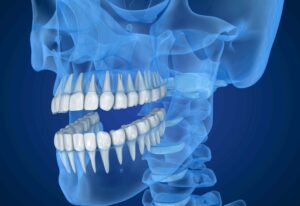
(5). Another feature is our Computerized Dental Implant Placement system. This advanced technology is designed for pre-surgical positioning of dental implants that uses a 3D model of the patient’s jaw. Once the implant type is selected, a template is developed for optimal treatment success, even for complex cases. This minimizes disruption of gum tissues and targets implant placement at ideal depths and angles. Thus, treatment success rates are higher with faster (and more comfortable) healing time.
(6). Optimal comfort for our patients has always been a priority. For many, a desired level of comfort and relaxation includes sedation options. Here, we offer several sedation options, including oral and IV sedation.
Oral sedation is a pill that helps patients relax. It also has an amnesiac effect, leaving most with little or no memory of treatment afterward. IV sedation (also known as “twilight sleep”) places the patient in a deeper sleep state and erases memory of the procedure. It is administered by a Medical Doctor (MD) who is a board certified Anesthesiologist.
With both sedation options, patients are closely monitored with advanced safety equipment throughout treatment.
If you are considering dental implants, you may wish to begin with a consultation appointment. During this time, we can explain the vast difference in comfort, treatment time, and success available through our specialized skills and extensive technology.
Call 828-274-9440 to schedule. New patients are always welcome and a referral is not always required.
Nothing To Fear To Accomplish Healthy Smile Here
Posted on Apr 16, 2023 by William J. Claiborne, DDS MS
As a dental specialist, I find that many people are unfamiliar with exactly what a periodontist does. Yet, when they are recommended to see me (typically by their general dentist), it is because they need specialized care that falls under our unique set of skills.
A periodontist has advanced skills to help patients with a variety of needs that involve the gum tissues. These include:
– Treatment of all stages of gum disease (gingivitis, pregnancy gingivitis, periodontal disease, periodontitis)
– Reshaping gum tissues for esthetic enhancement (crown lengthening, gingivectomy for ‘gummy smiles’, repairing areas of gum recession)
– Diagnosis and placement of dental implants
– Treatment of lesions or cysts in oral tissues
Let’s begin with gum disease.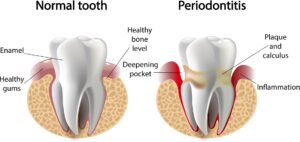
Because the majority of care I provide has to do with the treatment of all stages of periodontal disease, it may be helpful to understand how this develops. Although many people delay or avoid regular dental care (mistakenly thinking “if nothing hurts, then nothing must be wrong”), I have a close-up view of its destructive nature. Its formation creates cavities, periodontal (gum) disease, and leads to eventual tooth loss.
Even people who are committed to a regimen of thorough at-home oral hygiene (twice-daily brushing, daily flossing), can be doing an insufficient job of removing the daily buildup of plaque. Plaque is a sticky film of bacteria that accumulates in the mouth. When not thoroughly removed, it can harden into a mass that attaches to the base of, or in-between, teeth.
In the form of tartar, this cement-hard mass of bacteria cannot be brushed or flossed away. Once tartar forms, it can only be removed by a dentist or hygienist using special tools. Without removal, it will continue to amass and attack gum tissues, working its way beneath the gum line.
Below the gums lie the support system for natural teeth, consisting of tissues, ligaments and bone. When the bacteria reach an uncontrollable level, they become infectious. As these infectious bacteria accumulate further, symptoms of gum disease become more apparent, such as tender or swollen gums or seeing blood in the sink when brushing teeth. Breath odor may be bad on a regular basis.
As symptoms worsen, the gums become red with infectious and loosen their grip around the base of teeth. The gums may become spongy and pus pockets may form. Breath odor at this point is persistently putrid. Eventually, the structures that support teeth are compromised and teeth may loosen. Gum disease is the leading cause of adult tooth loss in the U.S.
Research has found that certain strains of oral bacteria from gum disease create reactions in the body that can trigger systemic inflammation. Thus far, research findings have shown a correlation between periodontal disease bacteria and some cancers (including pancreatic and lung), Alzheimer’s disease, pre-term babies, heart disease, stroke, diabetes, arthritis and erectile dysfunction (ED).
As if all that weren’t bad enough, one study suggests that gum disease relates to a reduction in one’s quality of life: “Periodontal disease has been linked to lower quality of life.” “Quality of life encompasses several domains, including psychological functioning and social relationships among others. Oral health-related quality of life has been shown to be reduced in patients with periodontal disease.” (https://www.hindawi.com/journals/prm/2017/5491923/)
While estimates show about 75 percent of American adults have some degree of dental fear or anxiety, over 47 percent have some level of periodontal disease. As a periodontist, both are alarming numbers. Nearly half our nation is walking around with a potentially life-threatening disease in their mouths.
Treating this may sound like it would be pretty intimidating. However, Although there are many treatments offered and at various levels, our main goal is to provide patients with comfortable and positive experiences at every visit. One way we accomplish this is through the advanced technology featured here in our Western North Carolina periodontal dental office. We feature some of the most advanced in dentistry, much of which is not available in dental offices elsewhere. Some of these features include:
LANAP With PerioLase MVP 7: Laser-Assisted New Attachment Procedure is an advanced protocol that efficiently and effectively treats advanced gum disease with the added advantages of a dental laser. This offers a non-surgical alternative for patients with moderate to severe periodontal disease. LANAP treatment leaves very little discomfort and has a quick recovery time. It has also been found to stimulate bone regrowth in damaged areas.
3D Cone Beam Imaging: Ideal for diagnoses and treatment planning, these images provide a clear view of the upper and lower jaw, used for: intricate review of endodontics; periodontics; orthodontics; implantology: TMJ; and prosthodontics, as well as dental and maxillofacial surgery. Because cone beam radiographs show sagittal, axial, and coronal planes, locating and tracking nerve canals optimizes implant placement. The process is quick, painless and at minimal levels of radiation.
CareStream Cone Beam Computer Tomography Imaging: This enhanced tomography works with 3D imaging for exceptional detail and range.
CS 3600 Intraoral Scanner: Rather than make impressions with bulky, goopy trays, this scanner quickly and comfortably captures digital impressions accurately and easily for creating precision models or appliances (crowns, inlays, onlays, bridges, orthodontic appliances and aligners, custom abutments). The scanner can also reach difficult–to–access areas in the patient’s mouth for superior results with improved patient comfort.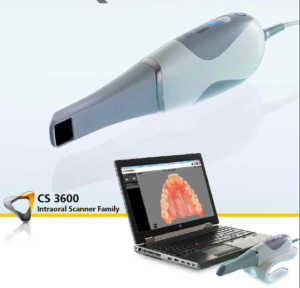
Computerized Dental Implant Placement: This advanced system for pre-surgical positioning of dental implants uses a 3D model of the patient’s jaw. Once the implant type is selected, a template is developed for optimal treatment success, even for complex cases.
In addition, we offer a unique environment for comfort. We understand how dental fear or anxiety can cause people to delay or avoid having dental treatment, sometimes for decades. We believe that every patient deserves respect, a gentle touch and knowing they are in a “lecture free” zone. For those who have high fear levels, we offer several sedation options, including oral and IV sedation.
Oral sedation is a pill that helps patients relax. It also has an amnesiac effect, leaving most with little or no memory of treatment afterward.
I.V. sedation (also known as ‘twilight sleep’) places the patient in a deeper sleep state and erases memory of the procedure. It is administered by a doctor of anesthesiology for optimal comfort and safety. In our Asheville office, anesthesia is overseen by a Medical Doctor (MD) who is a board certified Anesthesiologist.
With both sedation options, patients are closely monitored with advanced safety equipment throughout treatment.
I hope I’ve given you a helpful and positive picture of what a periodontist does and how he/she can help you with some challenging needs; all the while keeping you comfortable, minimizing treatment time, and shortening treatment time.
Although most of our patients are referred to us by other dentists and dental specialists, a referral is not required for accepting a new patient. Call 828-274-9440 if you feel we can make recommendations for your specific needs or provide helpful information.
“Gray Tsunami” Brings New Numbers in Dementia, Alzheimer’s
Posted on Feb 11, 2023 by William J. Claiborne, DDS MS
The American Academy of Periodontology (perio.org), defines a periodontist as:
“A periodontist is a dentist who specializes in the prevention, diagnosis, and treatment of periodontal disease, and in the placement of dental implants. Periodontists are also experts in the treatment of oral inflammation. Periodontists receive extensive training in these areas, including three additional years of education beyond dental school. They are familiar with the latest techniques for diagnosing and treating periodontal disease, and are also trained in performing cosmetic periodontal procedures.”
As an Asheville periodontal specialist for over 25 years, my advanced skills help patients with a variety of needs that involve the gum tissues. These include:- Treatment of all stages of gum disease (gingivitis, pregnancy gingivitis, periodontal disease, periodontitis)
– Reshaping gum tissues for esthetic enhancement (crown lengthening, gingivectomy for ‘gummy smiles’, repairing areas of gum recession)
– Diagnosis and placement of dental implants
– Treatment of lesions or cysts in oral tissues
Why should you be concerned about the health of your gums?
Gum disease is an inflammatory disease that attacks gum tissues, teeth, and the structures that support them. It is the nation’s leading cause of adult tooth loss. As if that weren’t bad enough, research has shown that these potent bacteria are able to activate the development (or worsen the progress) of other diseases.
Past studies have shown oral bacteria from gum disease can be a contributing factor to heart disease, stroke, some cancers, diabetes, preterm babies, erectile dysfunction (ED), high blood pressure, and impotency. Studies have begun to closely study the links between gum disease and Alzheimer’s disease.
In the U.S., the growing prevalence of dementia and Alzheimer’s disease is an especially concerning issue as our aging population grows. If you are a “baby boomer” (born between the years 1946 – 1964), you make up a significant percentage of adults. Within 7 years, boomers” will comprise 21% of the population. By 2060, nearly 1 in 4 Americans will be 65 years and older, dubbed the “gray tsunami.” Seniors over the age of 85 will have tripled, with half a million adults having reached age 100-plus.
While the statistics of aging adults increase, these stats for ALL adults over the age of 30 should set off some alarms. Nearly half of the adult population has some level of gum disease, over 47%.
There is a misconception many have when it comes to the serious nature of gum disease. Too often, people perceive “if it doesn’t hurt, then nothing is wrong” when it comes to their oral health. Although symptoms of gum disease may include tender gums that bleed when brushing, gum disease can begin without any obvious signs.
This is true for many health problems. For instance, when cancer forms in the body, its initial presence isn’t obvious. This is why annual or periodic screenings are urged since treatment is typically minimal during early stages.
Early treatment, including that for gum disease, helps to resolve the problem without complex measures. This is why it is so important to have 6-month dental check-ups. These visits allow your dentist to catch gum disease early so treatment needs and expense can be minimal.
Yet gum disease is a hazard for your overall health as well. While gum disease forms in the mouth, that’s not necessarily where it remains without proper treatment. The bacteria of gum disease can enter the bloodstream. It has been found to trigger serious reactions elsewhere in the body. Some of these lead to the formation of cancer (oral, throat, pancreatic, lung) and some activate conditions such as diabetes and arthritis.
Obviously, the health of your mouth is an important part of supporting a healthy body, especially in disease prevention. To illustrate the extent of gum disease’s damaging impact to health, research is tracking its correlation to dementia and Alzheimer’s disease.
In a recent study that included over 8,200 adults, an increased risk for developing dementia was found in those having severe gum disease and missing teeth. Participants in the study had an average age of 63 at the study’s onset.
In a follow-up after 18 years, those who had severe gingivitis in addition to tooth loss had a 22% higher risk for developing Alzheimer’s disease or dementia. Having no natural teeth was associated with a 26% increased risk.
Broken down, 14% of individuals with healthy gums and all their teeth at the start of the study developed dementia by the end of the study. For those with mild gum disease, 18% (623 out of 3,470) developed dementia. Twenty-two percent of participants with severe gum disease developed dementia. For those who had no remaining teeth, 23% developed dementia – nearly 17 cases for every 1,000 persons.
They found the bacteria present in periodontal disease can travel through the mucous membranes of the mouth to the brain, potentially causing brain damage.
In the study, participants were carefully assessed based on age, gender, education, cholesterol, high blood pressure, coronary heart disease, smoking and body weight. (https://psychcentral.com/news/2020/07/30/gum-disease-may-be-linked-to-later-dementia/158497.html?MvBriefArticleId=25473)
Prior studies have led researchers to be more focused on tracking oral tissue related factors that may contribute to dementia and Alzheimer’s disease, which is affecting a growing percentage of American adults (as well as those globally). Currently, 10% of adults age 65 and over have Alzheimer’s disease. For people ages 85 and older, this increases to 32 percent. In the U.S., it is the 6th leading cause of death. (https://www.alzheimers.net/resources/alzheimers-statistics/)
By the year 2025, the number of people 65 and older with Alzheimer’s disease is expected to reach 7.1 million people, a 27 percent increase from the 5.6 million age 65 and older in 2019.
Let us help you minimize the risks associated with oral bacteria. If dental fear has kept you from having regular dental care, we will be happy to discuss our many comfort options in our comfortable Asheville office, including Oral and I.V. sedation (“twilight sleep”).
Oral sedation is a pill that helps patients relax. It also has an amnesiac effect, leaving most with little or no memory of treatment afterward. I.V. sedation (also known as ‘twilight sleep’) places the patient in a deeper sleep state and erases memory of the procedure. It is administered by a doctor of anesthesiology for optimal comfort and safety.
Here, our Western North Carolina periodontal dental office also features some of the most advanced technology in dentistry. Many of these are not available in other dental offices elsewhere. Some of these features include LANAP (Laser-Assisted New Attachment Procedure. This is an advanced protocol that efficiently and effectively treats advanced gum disease with the added advantages of a dental laser. We also have 3-D Cone Beam Imaging, computerized Tomography imaging and one of the latest in intraoral scanners.
Now, more than ever, we know that maintaining a healthy smile is important and achievable for every adult. If you suspect you have gum disease (gums that bleed when brushing, tender or swollen gums, gums that have reddened or receded from teeth), it is important to be seen by a periodontist. A periodontal specialist is the best way to restore any level of gum disease to help you regain a healthy smile.
Be committed to having excellent oral health as and make it a priority as an important part of your overall health. For a consultation to discuss how a periodontist can help you, call 828-274-9440.
Choose A Periodontist To Correct A Gummy Smile
Posted on Aug 29, 2022 by William J. Claiborne, DDS MS
About Periodontal Plastic Surgery
When Lauren Hutton, the model well-known for a space between her front teeth, began modeling, she felt she needed to camouflage the gap (or “diastema”). Yet, she soon began to feel it was a unique feature that set her apart from the others. She was right, and now at the age of 77, she’s been on more front covers than nearly any other model.
Each smile is unique. Hopefully, your smile makes you feel good every time you share it. And, the very act of smiling has been shown to release endorphins in the brain. Those are the chemicals that create a bit of a ‘natural high.’ Smiling is obviously an asset to our well-being.
If you have a “gummy” smile, you may be perfectly fine with it. After all, it is not detrimental to oral health if you care for your gums properly (which goes for everyone). And, it can be a positive part of your personality. Katie Couric has a gummy smile and shares hers openly.
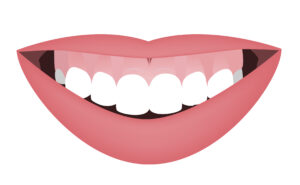
“Gummy” Smile
However, not everyone with this trait feels comfortable with the look nor the way it makes them feel when smiling. Some people tend to suppress a full smile. Others often conceal their smile with a hand when smiling fully or laughing. Some people smile with their lips only.
A gummy smile, in the periodontal specialty, is known as EGD, an abbreviation for excessive gingival display or a gingival smile (GS). The trait occurs more often in females than in males. (Gingival is of or relating to the gums.)
Esthetically, a balanced smile typically shows the front top 6 or 8 teeth. Arching each tooth, there is generally minimal gum tissues showing , and sometimes none. Another esthetic complement to a smile is having gum tissues that show a slight arch over each tooth at a similar line as those that arch adjacent teeth. Gums that are lower over one or two teeth tend to create a jumbled look in a full smile.
When the height of gum tissues distract from the appearance of a smile, a periodontist is your expert. This dental specialist has specialized skills in all aspects of oral tissues. Through their advanced training, they are able to safely and beautifully reshape the tissues that surround teeth.
For people who wish to have a gummy smile or uneven gum line re-contoured, a periodontist performs a gingivectomy. A gingivectomy is a procedure during which excess gum tissue is remove. During this, the gumline is sculpted to give your smile balance with a more even smile line.
In addition to repairing a gummy smile, a gingivectomy is involved in a procedure known as crown lengthening. Crown lengthening involves removing the excessive gum tissue to expose more of the crown of the tooth, as well as sculpting the gumline to make it higher up. After the gum tissues are shaped, a crown is typically placed to protect the tooth above the gum line and to create a more beautiful smile.
A crown lengthening may also help to save a tooth from removal. When a tooth breaks off near the gum line, a crown lengthening can be performed to expose a sufficient amount of the tooth’s base so it can support a crown.
Another procedure a periodontist expertly performs is gum grafting. This is often to cover exposed roots, to reduce further gum recession, protect vulnerable tooth roots from decay, and improve your smile. Recession can occur as a result of periodontal disease, which causes tooth roots to become exposed and makes the teeth look long.
Gum tissues are very tender tissues with many nerves. Procedures that involve the gums must be performed with precision to minimize discomfort and speed healing time. A periodontist excels in the skills to create an optimal outcome with the most conservative treatment needed.
Our Asheville periodontal dental office provides some of the most advanced imaging and computerized technology available. This includes cone beam 3D imaging and laser dentistry. Additionally, we provide oral and IV sedation (“twilight sleep”) so patients are able to relax or snooze comfortably while being monitored by specially-trained team members who use advanced safety equipment.
Begin with a consultation with an experienced periodontist, who can answer your questions thoroughly and determine the best treatment option for your individual needs. Call 828-274-9440.
Some sources:
https://www.colgate.com/en-us/oral-health/mouth-and-teeth-anatomy/3-treatment-options-for-a-gummy-smile
https://www.researchgate.net/figure/Female-and-male-percentages-in-the-gummy-smile-sample_tbl1_340258838
Recent Posts
Categories
Archives
- April 2024
- March 2024
- February 2024
- January 2024
- December 2023
- November 2023
- October 2023
- September 2023
- August 2023
- July 2023
- June 2023
- May 2023
- April 2023
- March 2023
- February 2023
- January 2023
- December 2022
- November 2022
- October 2022
- September 2022
- August 2022
- July 2022
- June 2022
- May 2022
- April 2022
- March 2022
- February 2022
- January 2022
- December 2021
- November 2021
- October 2021
- September 2021
- August 2021
- July 2021
- June 2021
- May 2021
- April 2021
- March 2021
- February 2021
- January 2021
- December 2020
- November 2020
- October 2020
- September 2020
- August 2020
- July 2020
- June 2020
- May 2020
- April 2020
- March 2020
- February 2020
- January 2020
- December 2019
- November 2019
- October 2019
- September 2019
- August 2019
- July 2019
- June 2019
- May 2019
- April 2019
- March 2019
- February 2019
- January 2019
- December 2018
- November 2018
- October 2018
- September 2018
- August 2018
- July 2018
- June 2018
- May 2018
- April 2018
- March 2018
- February 2018
- January 2018
- December 2017
- November 2017
- October 2017
- September 2017
- August 2017
- July 2017
- June 2017
- May 2017
- April 2017
- March 2017
- February 2017
- January 2017
- December 2016
- November 2016
- October 2016
- September 2016
- August 2016
- July 2016
- June 2016
- May 2016
- April 2016
- March 2016
- February 2016
- January 2016
- December 2015
- November 2015
- October 2015
- September 2015
- August 2015
- July 2015
- June 2015
- May 2015
- April 2015
- March 2015
- February 2015
- January 2015
- December 2014
- November 2014
- October 2014
- September 2014
- August 2014
- July 2014
- June 2014
- May 2014
- April 2014
- March 2014
- February 2014
- January 2014
- December 2013
- November 2013
- October 2013
- September 2013
- August 2013
- July 2013
- June 2013
- May 2013
- April 2013
- March 2013
- February 2013
- January 2013
- December 2012
- November 2012
- October 2012
- September 2012
- August 2012
- July 2012
- June 2012


